- Home
- Blog
- Medical Dermatology
- When is a mole not a mole, but a benign skin growth?
When is a mole not a mole, but a benign skin growth?
As we get older, we all accumulate skin growths. Although many people may call these growths, “moles”, they can be altogether different. As SkinCare Physicians dermatologists, we perform full skin examinations frequently to screen for new or changing skin growths that might be skin cancers or precursors to skin cancers. While performing these so-called “mole patrols”, we commonly see many normal skin lumps and bumps that are not moles at all! Remaining vigilant by monitoring your own skin and scheduling an appointment with your dermatologist when you notice changing moles, is important. Understanding when a mole is not a mole, but a harmless skin growth, could relieve you from unnecessary stress. Read on to learn more about these mole mimics.
Seborrheic keratoses are not moles
Seborrheic keratoses (SKs) are benign growths that typically occur after age 40. These SKs can occur anywhere on the body, but they are especially common along the hairline and at sites of friction on the body. Seborrheic keratoses are harmless skin growths, and in fact, they are so benign that there is no significant research that has been done to discover their cause! Because so little is known about seborrheic keratoses, dermatologists do not know how to prevent them, but we do know that they are not contagious or dangerous.
Seborrheic keratoses can range in color from very light tone to deep, dark black. It is these deeply pigmented SKs that often appear alarming and bring patients into the office. Even when they change color, however, they are benign. SKs can become irritated, and for this reason, dermatologists commonly treat them with liquid nitrogen. Liquid nitrogen cryotherapy essentially induces a superficial frostbite to the SK, irritating it further so that it eventually drops off on its own without any surgical treatment. The advantage of this treatment is that, unlike surgical removal, there is a low risk of scarring.
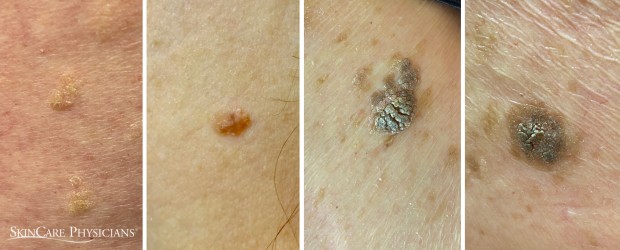
Seborrheic keratoses range from light to dark tone
Cherry hemangioma: a benign skin growth
Cherry hemangiomas are very common bright red bumps that appear on the skin, typically over the age of 30. These benign blood vessel growths are often bright “cherry” red, although they can sometimes develop more sluggish blood flow through them and appear more purplish. This can be an alarming change. It is always the right step to bring any new or changing skin growth to the attention of your dermatologists, but we are always happy to be the bearer of good news when it turns out that the spot in question is a benign cherry hemangioma.
Cherry hemangiomas are usually asymptomatic, but occasionally they can be traumatized and bleed. In that case, your dermatologist can cauterize the site with an electrocautery device. Vascular laser treatments may also be useful for removing these spots for cosmetic purposes.
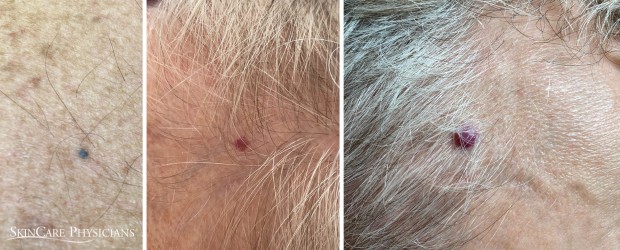
Cherry hemangiomas range from purplish to red
Dermatofibroma: how to spot this harmless skin growth
Dermatofibromas (DF) are typically light reddish-brown bumps on the skin that can occur at any age. Although they are brown, they are not moles at all. While moles are formed by cells called melanocytes, DFs are formed by fibrous cells deeper in the skin. What is typical with a DF is that, unlike a mole, they are very firm, often described as a hard pea beneath the surface of the skin. When you squeeze a DF skin growth from either side, it characteristically dimples in the middle.
Dermatofibromas may occur anywhere on the body, but they are particularly common on the extremities. They are thought to be a response to some minor trauma such as an insect bite or a medical injection. In fact, one of the reasons they are so common on women’s legs is that they represent a response to nicking the skin while shaving. Dermatofibromas may be a nuisance, but unless they are very bothersome, dermatologists often recommend leaving them alone. Surgical excision comes with a fairly significant recurrence rate, along with a surgical scar that may be more bothersome than the original DF. Liquid nitrogen cryotherapy may sometimes flatten a DF and make it less visible or irritating, but the treatment rarely results in complete resolution of the spot.
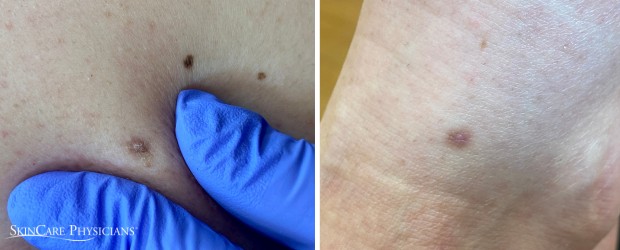
Dermatofibromas are typically light reddish-brown bumps
Skin tags
Skin tags, sometimes also called “acrochordons”, are a response of the skin to chronic friction, so they tend to occur on areas of the skin prone to rubbing, such as under the arms, at the base of the neck, or in the groin. These soft outpouchings of skin are completely benign, but they can certainly be irritating. Skin tags may occur at any age, and they may be seen more commonly in the setting of overweight or pregnancy. Many skin tags begin as skin-colored bumps, but they may evolve to become more pigmented. Any changing lesion on your skin should be evaluated by a dermatologist, but this particular change is considered benign.
Skin tags may become irritated or bleed in response to friction, and they may be removed for that reason. Small skin tags can be treated in the office with cryotherapy (liquid nitrogen). Larger skin tags are often best removed by snipping them off with a surgical blade. These larger ones often have a loop of blood vessels within them that bleed upon removal, and your dermatologist can address this with electrocautery after removal.
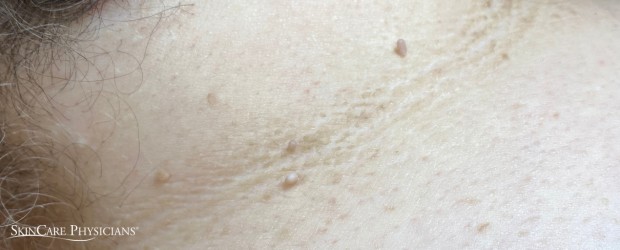
A skin tag is a benign skin growth
These are just a few of the myriad of benign skin growths that may be seen on skin exam of many of our patients at SkinCare Physicians. Years of clinical training allows our expert dermatologists to diagnose these on the basis of clinical appearance alone, although occasional biopsy may be performed to get an even clearer diagnostic picture. If you notice any new or changing lesion on your skin, please contact our office for an evaluation.

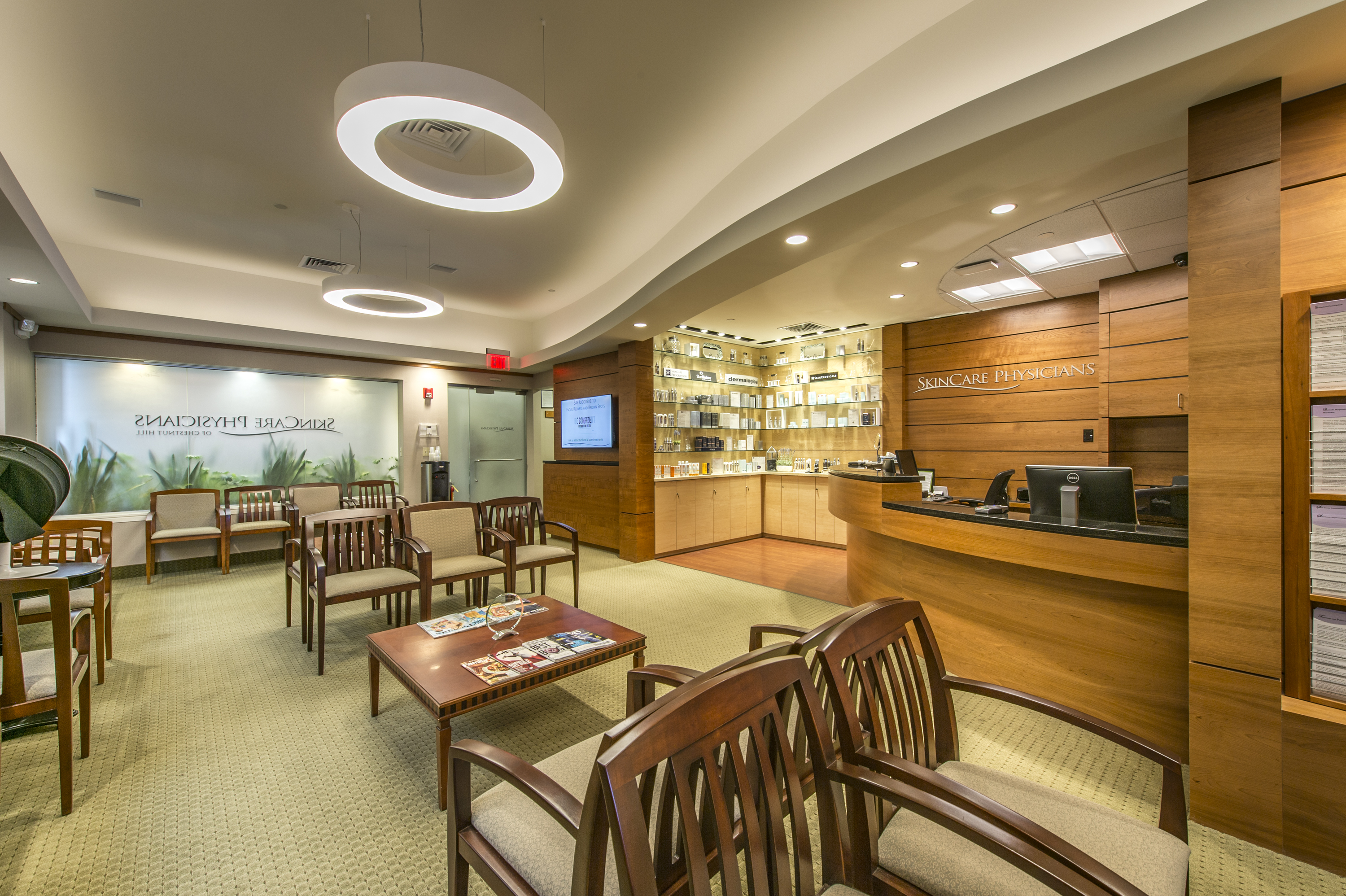

I’ve had this skin bump on my upper lip for 3 years at least. The Md’s I have seen try to treat it with cryotherapy and the treatment does not do anything to the bump which is rough skin color bump. What is the next step that can be done to remove this skin problem?
We encourage you to schedule an appointment for further evaluation with us or with a board-certified dermatologist in your area. If the skin bump is not responding to liquid nitrogen treatment, it may need more aggressive treatment or a biopsy.